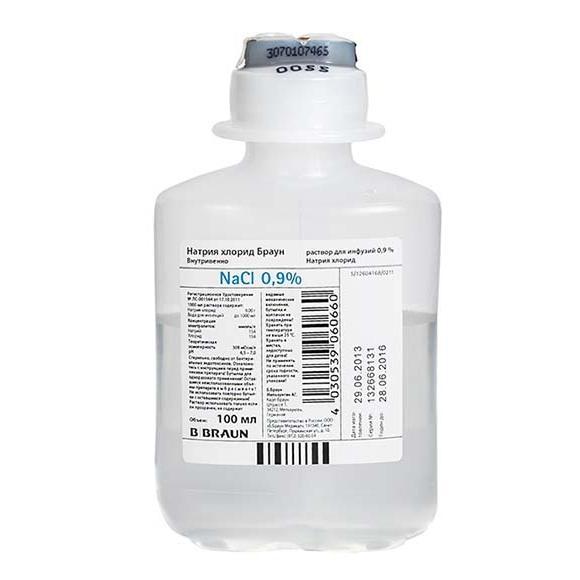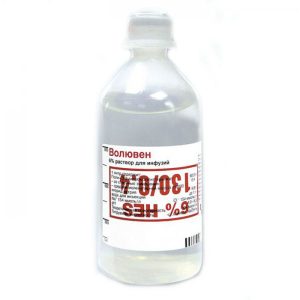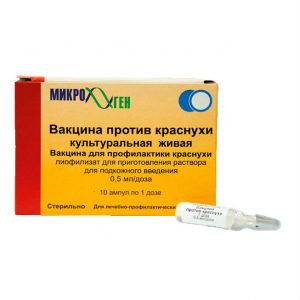Description
Release form
Infusion solution 0.9% transparent, colorless.
Packaging
20 vials.
Pharmacological action
It has a detoxifying and rehydrating effect. Replenishes sodium deficiency in various pathological conditions of the body and temporarily increases the volume of fluid circulating in the vessels.
The pharmacodynamic properties of the solution are due to the presence of sodium ions and chloride ions. A number of ions, including sodium ions, penetrate the cell membrane using various transport mechanisms, among which the sodium-potassium pump (Na-K-ATPase) is of great importance. Sodium plays an important role in signaling in neurons, electrophysiological processes of the heart, as well as in metabolic processes in the kidneys.
Sodium is excreted mainly by the kidneys, however, while a large amount of sodium undergoes reabsorption (renal reabsorption). A small amount of sodium is excreted in feces and during perspiration.
Indications
– isotonic extracellular dehydration
– hyponatremia
– dilution and dissolution of parenteral drugs (as a base solution).
Contraindications
– hypernatremia, acidosis, hyperchloremia, hypokalemia, extracellular hyperhydration
– circulatory disorders threatening cerebral and pulmonary edema
– cerebral edema, pulmonary edema, acute left ventricular failure, concomitant administration of corticosteroids in large doses.
When adding other drugs to the solution, contraindications to these drugs should be considered.
Precautions: decompensated chronic heart failure, arterial hypertension, peripheral edema, preeclampsia, chronic renal failure (oligo-, anuria), aldosteronism and other conditions associated with sodium retention in the body.
Special instructions
During any infusion, it is necessary to monitor the patient’s condition, clinical and biological indicators, it is especially important to evaluate plasma electrolytes. In the body of children, due to the immaturity of renal function, sodium excretion may slow down. Therefore, in such patients, repeated infusions should be carried out only after determining the concentration of sodium in the plasma.
Use only a clear solution, with no visible inclusions if the packaging is not damaged. Enter immediately after connecting to the infusion system. Do not use serial connection of plastic containers. This can lead to air embolism due to the suction of air remaining in the first container, which can occur before the solution arrives from the next container. The solution should be administered using sterile equipment in compliance with aseptic and antiseptic rules. In order to avoid air entering the infusion system, it should be filled with a solution, releasing the residual air from the container completely. Other drugs can be added to the solution before or during infusion by injection into the container area specially designed for this purpose.
As with all parenteral solutions, the compatibility of the added substances with the solution should be determined before dissolution.
Should not be used with 0.9% sodium chloride solution, known as incompatible with it. The doctor should determine the compatibility of added medicinal substances with a 0.9% sodium chloride solution, checking for a possible change in color and / or appearance of a precipitate, insoluble complexes or crystals.
Before adding, it is necessary to determine whether the added substance is soluble and stable in water at a pH level, as in a sodium chloride solution of 0.9%.
When adding the drug, it is necessary to determine the isotonicity of the resulting solution before infusion. Before adding drugs to the solution, they must be thoroughly mixed in compliance with aseptic rules. The prepared solution should be introduced immediately after preparation, do not store!
The addition of other drugs or a violation of the administration technique may cause fever due to the possible ingestion of pyrogens. In case of development of undesirable reactions, it is necessary to immediately stop the introduction of the solution. Before using the solution, do not remove the container from the external protective polypropylene / polyamide bag in which it is placed, since it maintains the sterility of the drug.
Instruction for the use of containers Viaflo (Viaflo)
1. Opening the package.
a. Remove the Viaflo container from the external bag just before use.
b. Compressing the container tightly, it is necessary to check it for its integrity. If mechanical damage is detected, the container should be disposed of, as sterility may be impaired.
in. Check the solution for transparency and no inclusions. The container should be disposed of if transparency is broken or inclusions are present.
2. Preparation for use.
For preparation and administration of the solution, use sterile materials as well. Hang the container by the loop on the tripod. Remove the plastic fuse from the outlet port located at the bottom of the container:
– grab the small wing on the mouth of the outlet port with one hand,
– grab the big wing on the lid with the other hand and twist,
– the lid will open.
in. When setting the infusion system, you should adhere to the rules of antiseptics.
d. Install the infusion system in accordance with the instructions for connection, filling the system and introducing the solution, which are contained in the instructions for the system.
3. Adding other drugs to the solution.
Caution: added drugs may not be compatible with the solution.
To add before introduction:
a. Disinfect the injection area on the container (drug injection port).
b. Using a syringe with a needle size 19-22 (1.10-0.70 mm), make a puncture in this area and inject the drug.
in. Thoroughly mix the drug with the solution. For high-density drugs, such as potassium chloride, gently inject the drug through a syringe while holding the container so that the drug input port is on top (upside down), then mix.
Warning: do not store containers in which prep gently inject the drug through the syringe, holding the container so that the drug input port is up (upside down), then mix.
Warning: do not store containers in which prep gently inject the drug through the syringe, holding the container so that the drug input port is up (upside down), then mix.
Warning: do not store containers in which preparata.
To add a drug during administration:
a. Turn the clamp of the solution control system to the Closed position.
b. Disinfect the injection area on the container (drug injection port).
in. Using a syringe with a needle size 19-22 (1.10-0.70 mm), make a puncture in this area and inject the drug.
d. Remove the container from the tripod and / or turn it upside down.
e. Remove air from both ports.
e. Mix the preparation thoroughly with the solution.
w. Return the container to its operating position, move the system clamp to the Open position, and continue with the introduction.
Dispose of containers after a single use. Every unused dose should be disposed of.
Do not reconnect partially used containers (regardless of the amount of solution left in it).
Influence on the ability to drive vehicles and control mechanisms
Not described.
Composition
1 l sodium chloride 9 g
Excipients: water d / i – up to 1 l.
Dosage and administration of
Intravenously (usually drip). The required dose can be calculated in mEq or mmol of sodium, mass of sodium ions or mass of sodium chloride (1 g NaCl = 394 mg, 17.1 mEq or 17.1 mmol of Na and Cl).
The dose is determined depending on the condition of the patient, the loss of body fluid, Na + and Cl-, age, body weight of the patient. Serum concentrations of electrolytes in plasma and urine should be carefully monitored.
The dose of sodium chloride solution for adults is from 500 ml to 3 liters per day.
The dose of sodium chloride solution for children is from 20 ml to 100 ml per day per kg body weight (depending on age and total body weight). The rate of administration depends on the condition of the patient.
The recommended dose when used to dilute and dissolve parenteral-administered drugs (as a basic solvent solution) is in the range from 50 ml to 250 ml per dose of the drug administered. In this case, the dose and rate of administration of the solution are determined by the recommendations for the use of the administered drug.
Side effects
Acidosis, hyperhydration, hypokalemia.
When used correctly, undesirable effects are unlikely.
When using sodium chloride 0.9% solution as a base solution (solvent) for other drugs, the probability of side effects is determined by the properties of these drugs. In this case, if adverse reactions occur, the administration of the solution should be suspended, the patient’s condition should be assessed, adequate measures should be taken, and the remaining solution should be retained for analysis, if necessary.
If any of the side effects indicated in the instructions are aggravated, or you notice any other side effects not listed in the instructions, inform your doctor.
Drug Interactions
Not described.
When mixed with other medicines, compatibility is visually monitored. To do this, one should observe the resulting solution for changes in its color and / or precipitation, the appearance of crystals, insoluble complexes. It is also necessary to take into account the instructions for the use of added drugs.
Overdose
Symptoms: nausea, vomiting, diarrhea, spasmodic abdominal pain, thirst, decreased salivation and tearing, sweating, fever, tachycardia, increased blood pressure, renal failure, peripheral pulmonary edema, dizziness, anxiety, irritability, weakness, muscle cramps and stiffness, generalized cramps, coma and death. Excessive administration of the solution can cause hypernatremia.
Excessive intake of chloride in the body can lead to hyperchloric acidosis.
When used as a base solution for diluting and dissolving other drugs, symptoms and complaints with excessive administration are most often associated with the properties of the drugs administered.
In case of unintentional excessive administration of the solution, treatment should be discontinued and the patient’s condition evaluated.
Treatment: symptomatic.
Storage Conditions
At a temperature not exceeding 25 ° C. Keep out of reach of children.
Deystvuyuschee substances
Sodium chloride
pharmacy terms for prescription
Form of Treatment
infusion solution
B. Braun Melstungen AG, Germany




